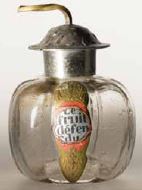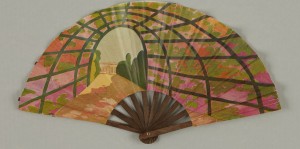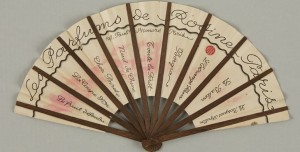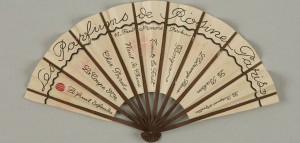We were recently gifted two very special objects: two paper publicity fans for the French perfume company, Rosine. Established in 1911, by the avant-garde couturier Paul Poiret following a trip to Vienna where he visited the Weiner Werkstatte, Rosine was part of Poiret’s greater vision to establish himself as not only a fashion designer, but a lifestyle brand.
In 1911, he also founded Martine, an interior design firm, which was comprised of three entities: École Martine, Atelier Martine and La Maison Martine. École Martine was an experimental art school for young, working-class girls, which Poiret ran with the assistance of his friend and collaborator Raoul Dufy. The instinctual designs realized by the Martine students were translated into wallpaper, rugs, textiles, hand-painted glasswear and other home furnishings by Atelier Martine and retailed through La Maison Martine boutiques located across Europe and via high-end department stores in the United States.

Poiret promoted his cosmetics brand, Rosine, at his fashion shows by handing out paper fans scented with his perfumes. The front of these two fans feature naive landscapes created by Martine students, while others were printed with designs created by top illustrators who regularly did branding projects for the house, including Paul Iribe and Georges Lepape, both of whom designed bottles and packaging for Rosine products.
The backs of the fans are segmented and printed radially with the names of Poiret’s signature scents. A red sticker applied to a specific segment indicates the perfume used to mist each fan. This spritzing is almost certainly the cause of the ink transfer seen on the rear of these two examples. Sadly, neither of these still bear a trace of the perfumes, Le fruit Défendu or L’Etrange Fleur, with which they were scented. This is not particularly surprising given these two examples are nearly one-hundred years old, dating to circa 1920.
Over the course of eighteen years, Rosine would release forty different scents with exotic and sensuous names like Nuit de Chine and Marahadja, which were very much in keeping with the orientalist fantasy of Poiret’s fashion designs. The earliest perfumes were created by a glassmaker and bottle designer, Maurice Schaller, who was replaced sometime around 1912 by perfumier Henri Alméras, who created the legendary scent Joy for another fashion designer, Jean Patou. Around this same time, Rosine began offering their perfumes two ways, in the standard—but luxurious—bottles created for each scent or contained within exquisite, hand-painted bulb atomizers from Martine.
Endeavors such as these seem quite common-place for fashion designers of today, who bring in millions of dollars each year through licensing their name to appear on fragrances, eyewear, and homegoods including linens, tablewear and furniture. (Ralph Lauren even has an eponymous line of interior paints!) This idea of fashion designer as tastemaker outside of the sartorial realm, however, began more than a century ago when Paul Poiret paved their way with the two companies he named after his daughters, Rosine and Martine.




3 responses to “Perfume+Publicity+Poiret”
Lucile sold a selection of exclusive house perfumes as early as 1907 so there was a couture precedent for Poiret’s fragrance line which, it should be noted, was never mass marketed. Neither did Lucile sell her scents outside of her special lingerie showroom, known as the Rose Room (decorated in the style of a boudoir). So while these revolutionary designers pioneered the high fashion fragrance, it remained for later designers Chanel, Patou, etc. to license perfume on a mainstream commercial basis.
This is really a large amount of information content-rich articles, I am glad that the author could get out to share with you It is very useful. Try to keep on posting these kind of things. Thanks for sharing.
Amazing article. I Have worked selling perfume since 3 years ago and for me is very important to know ths history of the product I deal with.
Thank you for share this.